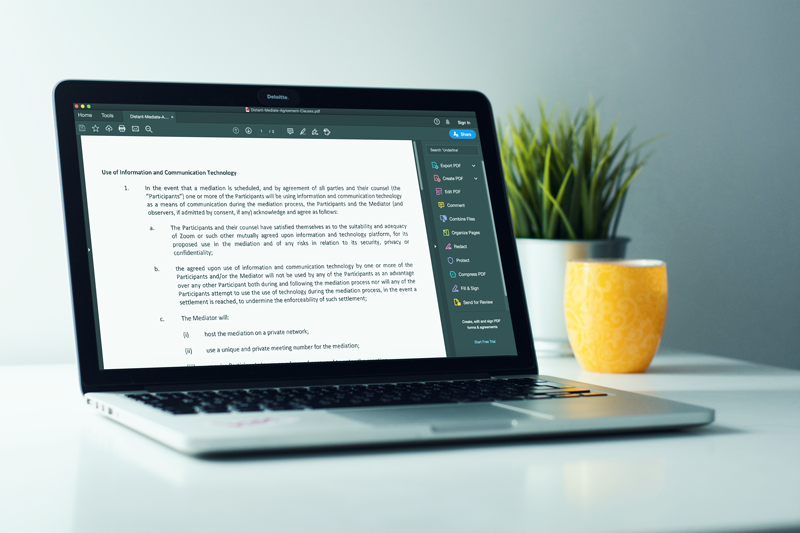Fri 24 Apr 2020
Sharing “Zoom Clauses” for our Agreements to Mediate
Posted by Sharon.Sutherland
While COVID-19 has led to widespread reflection on the critical importance of greater accessibility to courts, many mediators and arbitrators were already conducting much of their practice through distance technology. Others have been much nimbler than the courts can be in pivoting their practices online.
Notably, the conflict resolution community has responded to changed circumstances by coming together though numerous meet-ups, online discussions, trainings, and communities of practice in a show of mutual support and collaboration. The genuine collegiality of our community has never been more apparent. For example, within Mediate BC’s own corner of the world:
- We created a Quarantine Conflict Resolution Service which hosts weekly best practices meetings for its members. More than 20 mediators joined this effort within the first 24 hours – all wanting to find ways to help and all sharing their experience and ideas. (Roster and associate mediators interested in learning more are encouraged to contact the Program Manager.)
- Mediate BC also collaborated with CoRe Conflict Resolution Society to host two Best Practices in Online Mediation workshops in March. Continuing demand for these discussions led CoRe to host a weekly Community of Practice session which is open to all mediators and typically draws a mix of professionals from BC to CA. The cross-border collaboration that has evolved through this weekly meeting means the sharing of more and varied experiences and ideas for working online, and has led to a rich exchange amongst new friends.
Amidst this collaboration, a common topic of discussion and sharing has been drafting (or revisiting) our Agreements to Mediate/Participate (AM/P) to include discussion of elements of confidentiality and platform selection that may not have been in everyone’s face-to-face agreements.
Common topics around the AM/P that come up for practitioners who have not used distance technology for any significant portion of their practice include:
- Agreement to conduct the mediation on a specific platform (or platforms) and acknowledgement by participants of any risks.
- Confirmation of means of sharing documents.
- Ensuring that parties are not recording the session.
- Ensuring that the session is not being broadcast in any way.
- Addressing who is present in joint sessions or might be able to overhear any part of the meeting.
- How “signatures” will be handled.
- Expanded waivers of liability.
Just as there are a multitude of ways in which other portions of an AM/P might be framed to meet the needs of specific practice areas, client groups, etc., there a many different ways in which mediators choose to address these topics. The important thing for mediators is to ensure that they are turning their minds to these topics in some way.
- Choice of platform is an evolving topic – Is Zoom/Google Hangouts/FaceTime/etc. secure enough? Do we need to be on video? Should we mix phone calls and videoconferencing and email? The key point for purposes of formulating an AM/P isn’t what platform(s) you choose to meet the participants’ needs; it’s simply that mediators and parties should make a conscious selection of what meets their needs and comfort level and should include an acknowledgement of that choice in their AM/P. That might include a more detailed acknowledgement of specific risks associated with a platform if that is appropriate for the subject matter, party characteristics, etc. Consider your own situation in deciding how much detail is required.
- Exchange of documents might well be included under the broader topic of platform choice, but is noted here separately to highlight the potential need for a separate discussion and agreement about whether documents will be shared through file uploads on a videoconferencing platform (which might give rise to questions about security in addition to any questions related to voice discussions) or sent by email or drafted via screen share by the mediator. If there will be an exchange of materials that might be sensitive or private, you may very well wish to address the topic explicitly in the AM/P.
- Recording is a topic that affects in-person mediations more and more as technology evolves but has not always been included within mediators’ AM/Ps. Shifts to Zoom and other videoconferencing platforms have raised our consciousness of the ease of recording a mediation. While participants can (and have) recorded in-person sessions on hidden cell phones and recorded phone calls with many different devices, the addition of a “record” button in videoconferencing has caused many mediators to question whether they have adequately addressed this possibility in the AM/Ps. Do you have a clause in your AM/P that addresses recording?
- Closely related to recording, but often overlooked, is the potential for parties to broadcast a mediation session. Any distance tool might be shared by parties (handwritten letters can be copied, scanned and circulated; emails have been forwarded), but the potential to livestream a mediation is a concern that most of us have not previously turned our minds to. As a mediator, you can turn off all of the options for broadcasting from within a platform, but it’s important to realize that anyone who wants to record and broadcast readily can find alternative methods. For that reason, consider whether you include a no broadcasting agreement in your AM/P.
- Who is in the room? And who might overhear the mediation? Many of us have experiences of parties listening at doors to private meetings, or entirely accidentally sitting near someone they didn’t know was part of the mediation in a coffee shop and overhearing conversation. It happens both intentionally and unintentionally in face-to-face mediations, and the same is true of online mediations. Does your AM/P require everyone to be in a private location or to make clear who is near?
- Signing documents can be handled many different ways when everyone is in different locations. Do you address how signatures will be obtained in your AM/P, including how the AM/P is signed? Consider adding a clause about signing in counterpart or circulating a single document (if needed).
- Some mediators will include waivers of liability in the AM/Ps by which parties are asked to waive the right to sue the mediator in case of a breach of confidentiality. These might be expanded to include waivers of liability for any breaches of confidentiality that occur through the use of a communication platform.
Samples
As you take the time to consider ways in which you might want to revise or expand your Agreement to Mediate or Agreement to Participate, here are a few samples of approaches that mediators have taken, and that are generously shared to assist others.
J.P. Boyd, QC - Sample Participation Agreements
J.P. posts his participation agreements on his website. Note that he has specific agreements for distance processes with counsel and also agreements for self-represented participants. His library of agreements offers ideas about how these documents might be adapted to specific circumstances.
Amanda Semenoff - Sample Agreement to Participate
Amanda generally works with clients who do not have counsel. As such, her Agreement to Participate offers a plain language approach which she adapts to meet party needs.
Diane Bell, QC - Sample "Use of Information and Communication Technology" Clauses
Diane shared this Zoom clause in training she offered, and generously agreed to have it shared further.
Conflict Intervention Service, San Francisco Bar - Mediation Confidentiality Agreement
Conflict Intervention Services has been operating online since its inception. Its mediators have generously shared their experience through many Community of Practice of meetings.
About the Author
Sharon Sutherland is the Director of Strategic Innovation at Mediate BC, as well as a Civil Roster mediator, a Child Protection Roster Mediator, and a highly experienced mediation trainer and mentor. An avid theatre-goer and participant, she is also the president of the Board of Directors of the Vancouver Fringe Festival.
Image from Asm Arif on Behance




